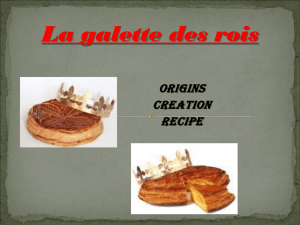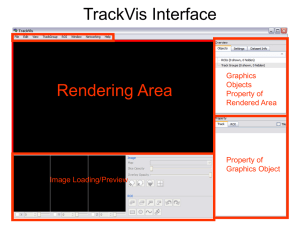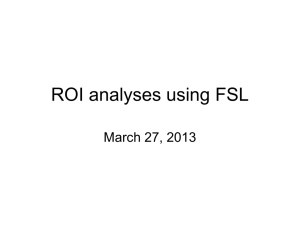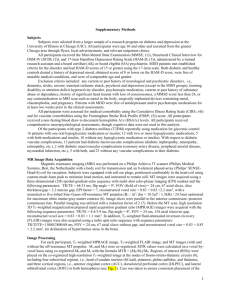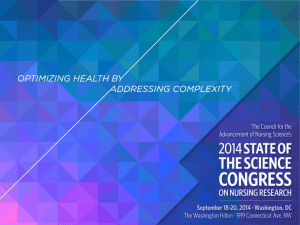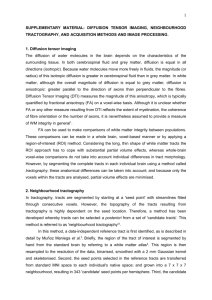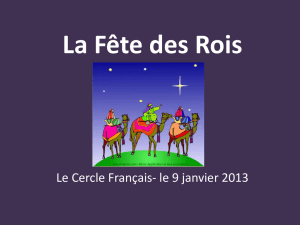SUPPLEMENTARY MATERIAL - Springer Static Content Server
advertisement
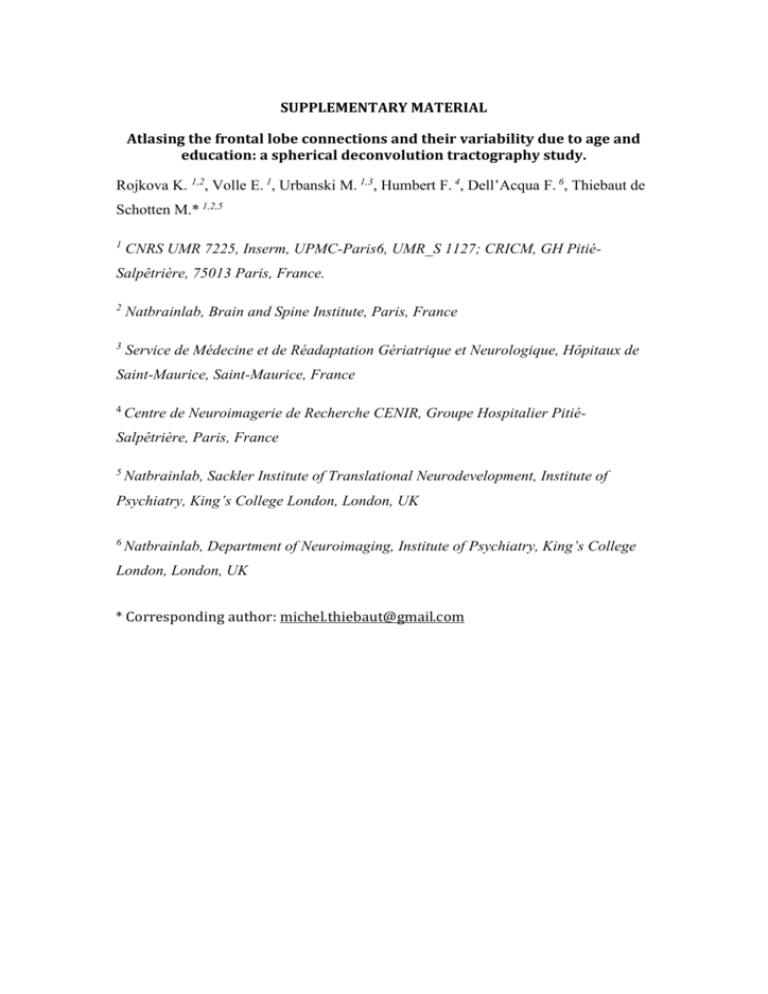
SUPPLEMENTARY MATERIAL Atlasing the frontal lobe connections and their variability due to age and education: a spherical deconvolution tractography study. Rojkova K. 1,2, Volle E. 1, Urbanski M. 1,3, Humbert F. 4, Dell’Acqua F. 6, Thiebaut de Schotten M.* 1,2,5 1 CNRS UMR 7225, Inserm, UPMC-Paris6, UMR_S 1127; CRICM, GH Pitié- Salpêtrière, 75013 Paris, France. 2 Natbrainlab, Brain and Spine Institute, Paris, France 3 Service de Médecine et de Réadaptation Gériatrique et Neurologique, Hôpitaux de Saint-Maurice, Saint-Maurice, France 4 Centre de Neuroimagerie de Recherche CENIR, Groupe Hospitalier Pitié- Salpêtrière, Paris, France 5 Natbrainlab, Sackler Institute of Translational Neurodevelopment, Institute of Psychiatry, King’s College London, London, UK 6 Natbrainlab, Department of Neuroimaging, Institute of Psychiatry, King’s College London, London, UK * Corresponding author: michel.thiebaut@gmail.com DIFFUSION-WEIGHTED IMAGING ACQUISITION AND PREPROCESSING A total of 70 near-axial slices were acquired on a Siemens 3 Tesla VERIO TIM system equipped with a 32-channel head coil. We used a fully optimised acquisition sequence for the tractography of diffusion-weighted imaging (DWI), which provided isotropic (2 × 2 × 2 mm) resolution and coverage of the whole head with a posterior-anterior phase of acquisition. The acquisition was peripherally-gated to the cardiac cycle (Conturo et al. 1995; Jones et al. 2002; Turner et al. 1990) with an echo time (TE) = 85 msec. We used a repetition time (TR) equivalent to 24 RR. At each slice location, 6 images were acquired with no diffusion gradient applied. Additionally, 60 diffusion-weighted images were acquired, in which gradient directions were uniformly distributed on the hemisphere with electrostatic repulsion. The diffusion weighting was equal to a b-value of 1500 sec mm−2. One supplementary image with no diffusion gradient applied but with reversed phase-encode blips was collected. This provides us with a pair of images with no diffusion gradient applied with distortions going in opposite directions. From these pairs the susceptibility-induced off-resonance field was estimated using a method similar to that described in (Andersson et al. 2003) and corrected on the whole diffusion weighted dataset using the tool TOPUP as implemented in FSL (Smith et al. 2004). Finally, at each slice, diffusionweighted data were simultaneously registered and corrected for subject motion and geometrical distortion adjusting the gradient accordingly (ExploreDTI http://www.exploredti.com) see (Leemans and Jones 2009) SPHERICAL DECONVOLUTION TRACTOGRAPHY RECONSTRUCTION Spherical deconvolution was chosen to estimate multiple orientations in voxels containing different populations of crossing fibers (Alexander 2006; Anderson 2005; Tournier et al. 2004). The damped version of the RichardsonLucy algorithm for spherical deconvolution (Dell'acqua et al. 2010) was calculated using a software that was developed in-house an free on demand to the authors. Algorithm parameters were chosen as previously described (Dell'Acqua et al. 2013). A fixed-fiber response corresponding to a shape factor of α = 1.5 × 10– 3 mm2/s was chosen (Dell'Acqua et al. 2013). For each participant, a convergence speed (CS) map of the deconvolution algorithm (Dell'acqua et al. 2006) was estimated. CS map quantifies how quickly the residual fitting error between the diffusion signal, and the fiber model as identified by the deconvolution algorithm decays within each voxel. CS maps better contrast white matter regions showing a smaller partial volume effect, as compared to FA or similar anisotropy maps. Fiber orientation estimates were obtained by selecting the orientation corresponding to the peaks (local maxima) of the fiber orientation distribution (FOD) profiles. To exclude spurious local maxima, we applied both an absolute and a relative threshold on the FOD amplitude. A first “absolute” threshold was used to exclude intrinsically small local maxima due to noise or isotropic tissue. This threshold was set to 3 times the mean amplitude of a spherical FOD obtained from a gray matter isotropic voxel (and therefore also higher than an isotropic voxel in the cerebro-spinal fluid). A second “relative” threshold of 10% of the maximum amplitude of the FOD was applied to remove the remaining local maxima with values greater than the absolute threshold (Dell'Acqua et al. 2009). Whole brain tractography was performed selecting every brain voxel with at least one fiber orientation as a seed voxel. From these voxels, and for each fiber orientation, streamlines were propagated using Euler integration with a step size of 1 mm (as described in Dell'Acqua et al. 2013). When entering a region with crossing white matter bundles, the algorithm followed the orientation vector of least curvature (as described in Schmahmann and Pandya 2007) Streamlines were halted when a voxel without fiber orientation was reached or when the curvature between two steps exceeded a threshold of 60°. Spherical deconvolution, fiber orientation vector estimations and tractography were performed using in-house software developed with Matlab 7.8 (http://www.mathworks.com). TRACTOGRAPHY DISSECTIONS We produced a CS-MNI152 template using Advanced Normalization Tools (ANTs, http://stnava.github.io/ANTs/) (Avants and Gee 2004; Avants et al. 2010), which build a template iteratively combining affine and diffeomorphic deformations (Avants et al. 2008; Klein et al. 2009). Participants were first realigned to the MNI using affine transformation. Then the template was built from all the subjects iteratively (n=4) using diffeomorphic deformations. In order to facilitate the tractography dissection, regions of interest (ROI) based on the guidelines provided in previous reports (anterior thalamic projections see (Behrens et al. 2003), main association fibers see (Catani and Thiebaut de Schotten 2008); subdivision of the arcuate see (Catani et al. 2007); fronto-pontine fibers see (Catani et al. 2008); frontal U-shape fibers see (Catani et al. 2012); fronto-striatal projections see (Cohen et al. 2009); SLF subdivision see (Thiebaut de Schotten et al. 2011a)) were defined on the CS-MNI template calculated above. In addition we performed tractography reconstruction of all the streamlines emerging from the frontal lobe and all streamlines not involving the frontal lobes. Detailed guidelines about the dissection can be found in supplementary online methods. For each participant, the CS Map was registered to the CS-MNI152 template using ANTs. The inverse deformation was then applied to the ROIs, as defined in the CS-MNI152, in order to bring them to the native space of every participant Individual dissections of the tracts were then visually inspected and corrected in trackvis (http://www.trackvis.org), when required, by two anatomists (KR and MTS) who manually readjusted the ROIs using rigid transformation. Tract-specific measurements, such as the relative volume (volume of the tract divided by the total volume of the brain), the fractional anisotropy (mean FA value for the whole tract, Basser et al. 1994) and a new index- employed as a surrogate for tract microstructural organization (i.e. mean Hindrance Modulated Orientational Anisotropy or HMOA for the whole tract Dell'Acqua et al. 2013) were extracted from each dissected tract. HMOA has the advantage of providing information about the microstructural diffusion properties of distinct fiber orientations and therefore specific to the orientation of the reconstructed tracts and more accurate than classical fractional anisotropy measures, which decreases when fibers cross due to local partial volume effect. 1 - Frontal and non-frontal tracts Supplementary Fig. 1: Delineation of the ROI used for the tractography of the frontal tracts and the non-frontal tracts. Left bullet, color legend for the ROI; right bullet, Boolean rules employed for the dissection. A one-ROI approach was used to isolate the frontal lobe streamlines. We draw a region of interest including the whole frontal lobe cortical ribbon. We only displayed streamlines that were either emerging or ending inside the frontal lobe cortical ribbon. For the non-frontal tracts we excluded from the whole brain tractography the streamlines connecting the frontal lobe cortical ribbon. 2 - Superior longitudinal fasciculus Supplementary Fig. 2: Delineation of the regions of interest (ROI) used for the tractography of the three subcomponents of the left and right parieto-frontal connections. A) Parietal ROIs in the left (PaL) and right (PaR) hemispheres. B) Frontal ROIs in the left (SFgL, MFgL and PrgL) and right (SFgR, MFgR and PrgR) hemispheres. C) Temporal ROI used to exclude the connections belonging to the temporo-frontal arcuate fasciculus in the left (TeL) and the right (TeR) hemispheres. Left bullet, color legend for the ‘AND’ ROIs; middle bullet, color legend for the ‘NOT’ ROIs; right bullet, Boolean rules employed for the dissection. A multiple region of interests (ROIs) approach was used to isolate the three components of the superior longitudinal fasciculus (i.e. SLF I, SLF II and SLF III). Three coronal ROIs were delineated around the white matter of the superior, middle and inferior/precentral frontal gyri, and another three ‘AND’ ROIs were delineated posteriorly in the parietal region. Streamlines of the arcuate fasciculus projecting to the temporal lobe were excluded using an axial ‘NOT’ ROI in the temporal white matter (the arcuate is not part of the longitudinal system as it forms an arc to reach the temporal lobe) 3 - Cingulum Supplementary Fig. 3: Delineation of the ROIs used for the tractography of the cingulum. A) Cingulum ROI in the left hemisphere (CinL). B) Cingulum ROI in the right hemisphere (CinR). C) Corpus callosum ROI in the medial section to exclude the connections belonging to the corpus callosum. Left bullet, color legend for the ‘AND’ ROIs; middle bullet, color legend for the ‘NOT’ ROI; right bullet, Boolean rules employed for the dissection. A two ROIs approach was used to isolate the left and the right cingulum fasciculi. A sagittal ROI was delineated around the white matter of the cingulum for the left and the right hemispheres. Streamlines of the corpus callosum projecting to the hemisphere opposite to the ROI were excluded using a sagittal ‘NOT’ ROI in the corpus callosum. 4 - Uncinate and inferior fronto-occipital fasciculus (IFOF) Supplementary Fig. 4: Delineation of the ROIs used for the tractography of the uncinate and the inferior fronto-occipital fasciculus (IFOF). A) External/Extreme capsule ROIs in the left (ECL) and the right (ECR) hemispheres. B) Temporal pole in the left (TPL) and the right (TPR) hemispheres. C) Occipital lobe in the left (OL) and the right (OR) hemispheres. Left bullet, color legend for the ‘AND’ ROIs; right bullet, Boolean rules employed for the dissection. A two ROIs approach was used to isolate the left and the right uncinate and inferior fronto-occipital fasciculi. A coronal ROI was delineated around the white matter of the externe/extreme capsule, an axial ‘AND’ ROI in the anterior temporal region and another coronal ‘AND’ ROI in the occipital lobe. 5 - Anterior and long segment of the arcuate fasciculus Supplementary Fig. 5: Delineation of the ROIs used for the tractography of the anterior and the long segments of the left A) and the right B) arcuate fasciculi. Left bullet, color legend for the ‘AND’ ROIs; right bullet, Boolean rules employed for the dissection. A two ROIs approach was used to isolate the left and the right anterior and long segment of the arcuate fasciculus. Three ‘AND’ sagittal ROIs were delineated around the white matter of the Broca territory (including ventral premotor, pars opercularis and the posterior portion of the middle frontal gyrus), Geschwind territory (including supramarginal gyrus and angular gyrus) and Wernicke territory (including posterior temporal lobe and the Heschl gyrus). 6 - Frontal corpus callosum, fronto-striatal projections, anterior thalamic radiations and fronto-pontine projections. Supplementary Fig. 6: Delineation of the ROIs used for the tractography of the frontal corpus callosum, left A) and right B) fronto-striatal projections, anterior thalamic radiations and fronto-pontine projections. Left bullet, color legend for the ‘AND’ ROIs; right bullet, Boolean rules employed for the dissection. A two ROIs approach was used to isolate the frontal projections of the corpus callosum and the left and right fronto-striatal, anterior thalamic radiation and fronto-pontine fibers. A ‘AND’ sagittal ROIs was delineated around the white matter of the corpus callosum. We also defined three ‘AND’ region around the whole striatum (including the caudate and the putamen), thalamus, pons whole and frontal lobe cortical ribbon and only displayed streamlines that were either emerging or ending inside these ROIs. 7 - Corticospinal tract Supplementary Fig. 7: Delineation of the ROIs used for the tractography of the left and right cortico-spinal tract. Left bullet, color legend for the ‘AND’ ROIs; right bullet, Boolean rules employed for the dissection. A two ROIs approach was used to isolate the cortico-spinal tract. A ‘AND’ ROIs was delineated around the precentral gyrus. We defined another ‘AND’ region around the cerebral peduncle. 8 - Paracentral, hand superior, hand middle, hand superior and face Ushaped Supplementary Fig. 8: Delineation of the ROIs used for the tractography of the left and right paracentral, hand superior, hand middle, hand inferior and face U- shaped. Left and middle bullets, color legend for the ‘AND’ ROIs; right bullet, Boolean rules employed for the dissection. A two ROIs approach was used to isolate the paracentral, hand superior, hand middle, hand inferior and face U-shaped in the left and the right hemispheres. Eight ‘AND’ axial ROIs were delineated in both hemispheres around the white matter of the anterior and posterior portion of the paracentral gyrus, the superior portion of the omega sign designating the motor hand area and its corresponding post-central area, the inferior portion of the omega sign and its corresponding post-central area, the most inferior portion of the pre- and postcentral gyri. Note that each axial ROI was delineated on three consecutive slices (approximately 6 millimeters thick). An upper length threshold of 50 millimeters was applied to the dissection to discard spurious reconstructions. 9 - Frontal aslant tract, superior and inferior frontal longitudinal fasciculi Supplementary Fig. 9: Delineation of the ROIs used for the tractography of the left and right frontal aslant tract, superior and inferior frontal longitudinal fasciculi. Left bullet, color legend for the ‘AND’ ROIs; right bullet, Boolean rules employed for the dissection. A two ROIs approach was employed to isolate the left and right frontal aslant tract, superior and inferior frontal longitudinal fasciculi. For each hemisphere we delineated an axial ‘AND’ ROI around the white matter of the superior frontal gyrus and a sagittal ‘AND’ ROI around the white matter of the inferior frontal gyrus (also including the pars opercularis, triangularis and orbitalis). Finally a ‘AND’ ROI was delineated around the white matter of the middle frontal gyrus in axial and sagittal sections. 10 - Fronto-insular tracts Supplementary Fig. 10: Delineation of the ROIs used for the tractography of the left and right fronto-insular tracts. Left and middle bullets, color legend for the ‘AND’ ROIs; right bullet, Boolean rules employed for the dissection. A two ROIs approach was used to isolate the fronto-insular tracts. Five sagittal ‘AND’ ROI were delineated in both hemisphere around the white matter of the pars orbitalis, pars triangularis, pars opercularis, inferior portion of the precentral gyrus, and the subcentral gyrus. We also defined another ‘AND’ ROI around the whole insula displayed streamlines that were either emerging or ending inside this ROI. An upper length threshold of 50 millimeters was applied to the dissection to discard spurious reconstructions. 11 - Frontomarginal and orbitopolar tracts Supplementary Fig. 11: Delineation of the ROIs used for the tractography of the left and righ frontomarginal and orbitopolar and tracts. Left bullet, color legend for the ‘AND’ ROIs; right bullet, Boolean rules employed for the dissection. A two-ROIs approach was used to isolate the frontal orbitopolar tract. Two coronal ‘AND’ ROI were delineated in both frontal lobes around the white matter of the lateral and the medial frontal pole separated by the frontomarginal sulcus, pars triangularis, pars opercularis, inferior portion of the precentral gyrus. For the orbitopolar tract we also defined another ‘AND’ ROI around the white matter of the posterior orbital gyrus. MAPPING OF THE FRONTAL LOBE CONNECTIONS Binary individual visitation maps were created for each tract by assigning each voxel a value of 1 or 0, depending on whether the voxel was intersected by the streamlines of the tract. Binary visitation maps of each dissected tracts were normalized to the MNI space using the same affine and diffeomorphic deformations as calculated above. We created percentage overlap maps by adding the normalized visitation maps from each subject at each point in the MNI space. Therefore, the overlap of the visitation maps varies according to intersubject variability. A similar approach has been reported in Thiebaut de Schotten et al. (Thiebaut de Schotten et al. 2011b) 3D brain rendering of the MNI152 template provided with the FSL package was calculated using MRIcroGL (http://www.cabiatl.com/mricrogl/). Percentage overlap maps of the tracts were projected onto the 3D rendering of the MNI152, in order to visualize cortical projections (Thiebaut de Schotten et al. 2011a). Probabilistic maps from the Jubrain (https://www.jubrain.fz-juelich.de) were employed to identify the corresponding Brodmann areas. The overall visualization and screenshots were performed in MRIcroGL. AGE-RELATED SHAPE CHANGES In this section we assessed whether the shape of the tracts change over age. We assessed this question by producing tractography maps for each decade (Supplementary Fig. 12b). We also quantified similarities using crosscorrelation between the maps for the 21-30 year-old maps and the maps for the other decades (Supplementary Fig. 12a). The result indicates that tracts reconstructed with tractography show a very high anatomical correspondence between decades and no decrease of this correspondence with age. Hence tractography in our sample did no argue for age related changes in the shape of the tract. Supplementary Fig. 12: Age related changes in the shape of the tracts. a) Crosscorrelation between decades. b) Example of tractography maps for each decade. SUPPLEMENTARY REFERENCES Alexander DC (2006) An introduction to computational diffusion MRI: the diffusion tensor and beyond. In: Visualization and Processing of Tensor Fields. Springer, Berlin, pp 83-106. Anderson AW (2005) Measurement of fiber orientation distributions using high angular resolution diffusion imaging. Magnetic resonance in medicine : official journal of the Society of Magnetic Resonance in Medicine / Society of Magnetic Resonance in Medicine 54 (5):1194-1206. Andersson JL, Skare S, Ashburner J (2003) How to correct susceptibility distortions in spin-echo echo-planar images: application to diffusion tensor imaging. Neuroimage 20 (2):870-888. Avants B, Gee JC (2004) Geodesic estimation for large deformation anatomical shape averaging and interpolation. Neuroimage 23 Suppl 1:S139-150. Avants BB, Epstein CL, Grossman M, Gee JC (2008) Symmetric diffeomorphic image registration with cross-correlation: evaluating automated labeling of elderly and neurodegenerative brain. Med Image Anal 12 (1):26-41. Avants BB, Yushkevich P, Pluta J, Minkoff D, Korczykowski M, Detre J, Gee JC (2010) The optimal template effect in hippocampus studies of diseased populations. Neuroimage 49 (3):2457-2466. Basser PJ, Mattiello J, Le Bihan D (1994) MR diffusion tensor spectroscopy and imaging. Biophysical Journal 66 (1):259-267. Behrens TE, Johansen-Berg H, Woolrich MW, Smith SM, Wheeler-Kingshott CA, Boulby PA, Barker GJ, Sillery EL, Sheehan K, Ciccarelli O, Thompson AJ, Brady JM, Matthews PM (2003) Non-invasive mapping of connections between human thalamus and cortex using diffusion imaging. Nat Neurosci 6 (7):750-757. Catani M, Allin MP, Husain M, Pugliese L, Mesulam MM, Murray RM, Jones DK (2007) Symmetries in human brain language pathways correlate with verbal recall. Proc Natl Acad Sci U S A 104 (43):17163-17168. Catani M, Dell'acqua F, Vergani F, Malik F, Hodge H, Roy P, Valabregue R, Thiebaut de Schotten M (2012) Short frontal lobe connections of the human brain. Cortex 48 (2):273-291. Catani M, Jones DK, Daly E, Embiricos N, Deeley Q, Pugliese L, Curran S, Robertson D, Murphy DG (2008) Altered cerebellar feedback projections in Asperger syndrome. NeuroImage 41 (4):1184-1191. Catani M, Thiebaut de Schotten M (2008) A diffusion tensor imaging tractography atlas for virtual in vivo dissections. Cortex 44 (8):11051132. Cohen M, Schoene-Bake J, Elger C, Weber B (2009) Connectivity-based segregation of the human striatum predicts personality characteristics. Nat Neurosci 12 (1):32-34. Conturo TE, McKinstry RC, Aronovitz JA, Neil JJ (1995) Diffusion MRI: precision, accuracy and flow effects. NMR Biomed 8 (7-8):307-332. Dell'Acqua F, Coward J, Simmons A, Murphy DGM, Williams S, Catani M (2009) Mapping Crossing Fibres of the Human Brain with Spherical Deconvolution: Towards an Atlas for Clinico-Anatomical Correlation Studies Proceedings of the International Society of Magnetic Resonnance Mededicine 17:3562. Dell'acqua F, Scifo P, Rizzo G, Catani M, Simmons A, Scotti G, Fazio F (2010) A modified damped Richardson-Lucy algorithm to reduce isotropic background effects in spherical deconvolution. Neuroimage 49 (2):14461458. Dell'acqua F, Scifo P, Rizzo G, Clark RA, Scotti G, Fazio F (2006) Convergence Maps from Richardson-Lucy Spherical Deconvolution Algorithm for the Detection of White Matter in HARDI. NeuroImage 31 (S1):S953-S953. Dell'Acqua F, Simmons A, Williams SC, Catani M (2013) Can spherical deconvolution provide more information than fiber orientations? Hindrance modulated orientational anisotropy, a true-tract specific index to characterize white matter diffusion. Hum Brain Mapp 34 (10):24642483. Jones DK, Griffin LD, Alexander DC, Catani M, Horsfield MA, Howard RJ, Williams SC (2002) Spatial normalization and averaging of diffusion tensor MRI data sets. NeuroImage 17 (2):592-617. Klein A, Andersson J, Ardekani BA, Ashburner J, Avants B, Chiang MC, Christensen GE, Collins DL, Gee J, Hellier P, Song JH, Jenkinson M, Lepage C, Rueckert D, Thompson P, Vercauteren T, Woods RP, Mann JJ, Parsey RV (2009) Evaluation of 14 nonlinear deformation algorithms applied to human brain MRI registration. NeuroImage 46 (3):786-802. Leemans A, Jones DK (2009) The B-matrix must be rotated when correcting for subject motion in DTI data. Magnetic Resonance in Medecine 61 (6):13361349. Schmahmann JD, Pandya DN (2007) The complex history of the fronto-occipital fasciculus. Journal of the History of the Neurosciences 16 (4):362-377. Smith SM, Jenkinson M, Woolrich MW, Beckmann CF, Behrens TEJ, JohansenBerg H, Bannister PR, De Luca M, Drobnjak I, Flitney DE, Niazy RK, Saunders J, Vickers J, Zhang Y, De Stefano N, Brady JM, Matthews PM (2004) Advances in functional and structural MR image analysis and implementation as FSL. Neuroimage 23 Suppl 1:S208-219. Thiebaut de Schotten M, Dell'Acqua F, Forkel SJ, Simmons A, Vergani F, Murphy DG, Catani M (2011a) A lateralized brain network for visuospatial attention. Nat Neurosci 14 (10):1245-1246. Thiebaut de Schotten M, Ffytche DH, Bizzi A, Dell'Acqua F, Allin M, Walshe M, Murray R, Williams SC, Murphy DG, Catani M (2011b) Atlasing location, asymmetry and inter-subject variability of white matter tracts in the human brain with MR diffusion tractography. Neuroimage 54 (1):49-59. Tournier JD, Calamante F, Gadian DG, Connelly A (2004) Direct estimation of the fiber orientation density function from diffusion-weighted MRI data using spherical deconvolution. NeuroImage 23 (3):1176-1185. Turner R, Le Bihan D, Maier J, Vavrek R, Hedges LK, Pekar J (1990) Echo-planar imaging of intravoxel incoherent motion. Radiology 177 (2):407-414.
